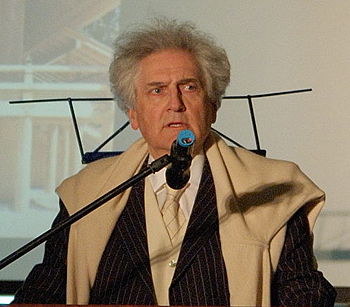Tough talk about New Urbanism

Dec. 9
By JoAnn Greco
For PlanPhilly
Under chandeliers flickering with simulated candlelight, and nestled between the graceful symmetry of Ionic columns, architects and other associated fans of traditional buildings filled Carpenter’s Hall Tuesday night to pay homage to Léon Krier.
The acknowledged “godfather” of the New Urbanism planning movement, the 63-year-old Krier is a tart polemicist who has long advocated bringing density and walkability — urban traits — to suburban towns. “I hesitate to call him New Urbanism”s ‘father,'” said John Blatteau, AIA, by way of introduction. “I don’t think he’d want to be credited with so many illegitimate offspring.”(Blatteau is president emeritus of the evening’s organizer, the Philadelphia chapter of the Institute of Classical Architecture & Classical America.)
The Luxembourg-born Krier, who famously has declared “I am an architect because I don’t build,” (his CV would list only a handful of actual structures), is best known as the man to whom the Prince of Wales turned for his development, Poundbury, in Dorset, and who served as the inspiration behind Andres Duany and Elizabeth Plater-Zyberk’s Seaside, in Florida. Those late-1980s projects have since spurred dozens of similar towns, with Prince Charles being decried as a smug traditionalist, while the Florida architects have been hailed as planning darlings and the guiding lights of “traditional neighborhood development.” Along the way, many would argue, Krier’s original ideas have been bastardized, if not lost.
It’s doubtful that any of the 70 or so attendees followed everything that Krier put out there. “I sat in on his interview with (Inquirer Architecture critic) Inga Saffron earlier today, so that helped,” laughed Steven Hendricks, an Allentown-area fabricator of reproduction historic doors, and the chapter’s vice president.
The ideas aren’t so complex. Like many of today’s planning buzzwords (think: “green”), the concepts behind new urbanism are made up mostly of common sense. But the elegant, white-haired Krier often took the simplest of statements and twisted them into the longest of sentences, speaking in a vaguely English accent overlaid with hints of French and German (call it Luxembourgish). Adding to the “picture is worth a thousand words” truism, though, his whimsical and often-biting illustrations (they’re also a prominent feature in his tracts, the latest of which is “Architecture Of Community”) amply hammered home his points. One screen showed traditional building elements and contrasted them with contemporary plays on the theme. So, a sketch of a six-over-six, double hung window, titled “I am a window,” was juxtaposed with one of a triangular cutout with random mullions, titled “Call me a window.” Gehry and Libeskind, you know who he’s talkin’ to.
The message is, primarily, that skyscrapers, grid intersections, car-centric planning, and use-specific zoning have destroyed our cities. In advocating for small scale, central plazas, walkable neighborhoods, and mixed-use, Krier echoes Jane Jacobs and “A Pattern Language.” But with his European sensibility and his tough consistency, he’s earned legions of fans for his frank conservatism. He finds much modern architecture “unbearable” and depicts our reliance on fossil fuels as a “hydra”.
Krier rails against what he calls “development architecture,” seeing money as the driving force behind excessive height. Not only should cities be horizontally pedestrian-friendly (he famously calls for town centers that are reachable on foot in less than five minutes from most points) but vertically (no need for unnatural “machines” like elevators; the best buildings are “those that are no more than three or four stories”). And, while he values some big structures (the Eiffel Tower, say) and some monumental buildings (churches, for example), he believes that scale should be attached to logic, that big should be for a reason (namely, symbolic).
“If. . . all buildings, settlements, suburbs and structures built after 1945 — especially those commonly called ‘modern’ — vanished from the face of the earth, would we mourn their loss?” he writes in his introduction to the new book. “If, on the other hand, some parallel phenomenon destroyed in one fell swoop the whole of our pre-World War II architectural heritage. . . what would be the significance of the event? What would be a greater loss?”
Questioners who asked where landscaping, land value, and public transit fit into his theories — hmmm, maybe Krier wasn’t entirely speaking to the converted? — were quickly shot down with ready aphorisms. “You’re in a town, so you don’t need landscaping. You only need landscaping if you don’t have a town,” he said to one audience member. “Not even window boxes? the questioner, persisted, timidly. “Of course, there are window boxes!” Krier retorted. “I take my pictures before people move in. . . .” As for transit networks and greater building heights to accommodate large populaces, they’re just tactics to encourage sprawl, he suggested. “Build towns, not skyscrapers,” he exhorted.
Krier, who the ICA&CA buttonholed at the last minute when it learned he would be literally passing through Philly from D.C. en route to New York, opened his presentation by picking on the midtown canyons of our fair city. “I came in by train and got out at your marvelous station,” he said. “Then, I opened the doors to rather a let-down. How can you call it ‘progress,’ going from that type of building to the ones I passed out there on the taxi ride?”
Perhaps, though, after he left Carpenter’s Hall, he navigated the darkened “landscape” of Independence National Historic Park, to reach the heart of Society Hill. Maybe there he found that parts of Philadelphia still are, as they have always been, “new urbanist.”
Contact the reporter:
JoAnn Greco
ASJA, SATW, NATJA
215 413 3137
www.joanngreco.com
Check out Greco’s new online magazine, TheCityTraveler
www.thecitytraveler.com
WHYY is your source for fact-based, in-depth journalism and information. As a nonprofit organization, we rely on financial support from readers like you. Please give today.






